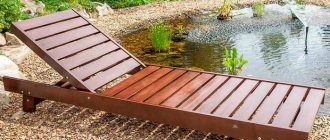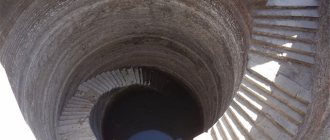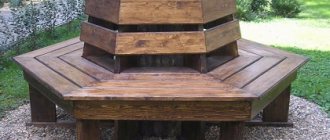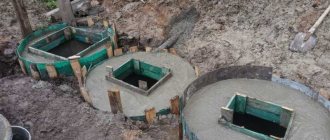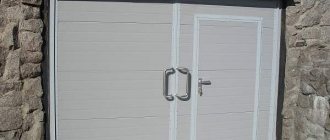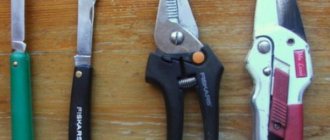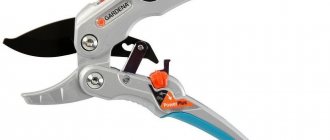Grafting pruner
Used in professional and amateur gardening. Makes it possible to obtain the highest percentage of survival rates , which is due to the exclusion of the human factor from the vaccination process.
Purpose and application
It is distinguished by a figured knife , which allows you to make a professional mirror cut, both on the scion and on the rootstock, after which you only need to accurately connect the parts. The grafting pruner is optimally suited for working with most fruit trees, and the success of the activities carried out when using such a tool exceeds 70-80%. The disadvantages include rare breaks in some areas of the junctions of the scion and rootstock.
However, the cuts obtained with a grafting pruner provide the smoothest and most even surfaces possible on the scion and rootstock. Excellent results can only be obtained by using high-quality raw materials in impeccable condition. It is optimal to purchase a set of knives with different configurations.
As a rule, the standard configuration includes three different knives: V-shaped, Omega-shaped and U-shaped . As an addition, it is recommended to take care of purchasing garden varnish, grafting tape and markers for seedlings or cuttings. The transparent version of the Professional Grafting Tape is very suitable for these purposes.
Types of grafting pruners (video)
Advantages and disadvantages
In addition to the main advantage in the form of the highest survival rate, the advantages include:
- simplicity and ease of all work performed, even in the complete absence of skill and experience on the part of the amateur gardener;
- the ability to graft not only annual shoots with a thickness of no more than 3-4 mm, but also more mature branches with a thickness of up to 1.3 cm;
- a long period of operation without loss of quality characteristics is due to the use of high-quality and modern materials in the manufacture. Most often, the guaranteed amount of work performed without the need to sharpen is about three thousand cuts.
The main advantage, according to most gardeners, is the ease of working on different types of wood, which is due to the presence of several types of interchangeable knives in the kit.

Professional pruners for grafting trees
In most cases, the market for grafting pruners is represented by professional tools, characterized by high quality characteristics and a well-thought-out working mechanism, as well as semi-professional and amateur tools designed for small household plots.
However, in recent years, amateur gardeners are increasingly faced with outright fakes, so it is important not only to familiarize yourself with the rating of the highest quality models, but also to know approximately how much a high-quality and durable tool costs. The price of a high-quality professional device cannot be less than two to three thousand rubles.
| Model | Characteristics and application features |
| Professional Grafting Tool | Delivery is carried out in different configurations, as well as with a screwdriver for changing knives, which are made of high-carbon steel SK-5 and are distinguished by a chrome-plated wear-resistant and anti-corrosion coating. The handles are made of reinforced plastic. The Belarusian analog instrument is somewhat cheaper |
| Artitec-3T | Allows you to provide an ideal option for curly pruning of the rootstock. Optimally suitable for performing crown-shaped grafting on plants with a diameter of no more than 4.5 cm. Forged knives are made from a high-carbon modern steel alloy |
| Artitec Manual Grafting 3T AR-INN3T | The main difference from the previous model is a special knife that allows budding or grafting with a bud. The cost of the tool is quite high, which is due to the manufacture of knives from high-quality high-carbon steel |
| Artitec Complementary GTafte | It is optimally suited for grafting thin cuttings and is often used as an additional garden tool. Used for cutting on a rootstock or when grafting using the “split” method |
| Due Buoi 303/21 | The Italian model of grafting pruner allows you to get perfect cuts without using significant effort. The device is equipped with very sharp forged knives of three types: U-shaped, Ω-shaped and kidney. Ideal for working with shoots with a diameter of no more than 1.1 cm |
Why you should buy a professional grafting pruner Grafting Tool
This professional tree grafting tool is considered the standard of quality. Made from the best tool steel, using the method of drawing the blade by forging, the knife does not become dull, as if it were cut into thick wood. With the help of very thin forged V-shaped, U-shaped and omega-shaped blades, you can make curly cuts with pruning shears for grafting trees and shrubs. The gardener decides which knife to use depending on the density of the wood. The nozzles are changed at the same time. They are double-edged and can withstand up to 3000 cuts. The tool has a 3-year warranty, which does not apply to consumables.
All other parts are made of reinforced plastic and high quality steel of no less quality. Sharpening knives requires a special device, but there is no need for sharpening:
- each side of the blade can withstand at least 3000 cuts, and there are 2 of them on each attachment;
- There are three attachments included with the professional grafting pruning tool;
- The store always has replacement nozzles that are not expensive.
There is an alternative to an expensive tool. Chinese and Belarusian manufacturers offer their products at a price several times lower than Italian instruments. Chinese models are good only for the first cuts. They easily bite into thin, fresh wood. Despite the manufacturer’s declared ability to work with grafting material with a cross-section of 13 mm, they become dull at the very first cuts and later fall apart from the applied forces.
The new tool, the grafting pruner, was patented in 1983 in the USSR. Invented by scientists Kostrikin I.A. and Melnichenko N.I., first for vineyards, and in 1992 for fruit and ornamental plants. The purpose of the invention was to facilitate the manual labor of peasants.
The Belarusian grafting pruner is made using tool steel for the knives and 20 steel for the handles and handles, making them stronger. Silicone pads add aesthetics. The zinc coating prevents corrosion of metal parts. Belarusian knives are of high quality, since the cutting part is drawn out by forging, just like Italian products. Such a grafting pruner costs 1,600 rubles and is available to villagers with low incomes.
How to make a grafting pruner with your own hands: drawings and manufacturing steps
To make your own grafting garden tool you will need competent drawings, as well as some skills and supplies. It is popular to make grafting pruners from common spadefoot. The main problem of creating a tool based on such a device is the need to sharpen knives yourself or order it from a mechanic. No less popular is the production of so-called grafting vices.
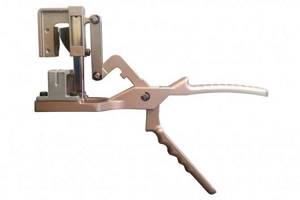
As the basis for such a tool, you need to take a small vice and fix a sharp and curved blade on the pin. The cut is made not by pressing, but by turning the handle. Working with such a homemade pruner takes longer, but is no less convenient and effective.
Also a very common homemade option is to modify the design of standard garden shears, which can be equipped with almost any blade for grafting pruners. Installation of knives is carried out using a special simple device in the form of a welded metal tube with cuts.
How to make the tool last a long time?
To begin with, you need to read in detail the instructions for the tool supplied by the manufacturer. The storage and operating conditions will be indicated here .
It is imperative to provide proper care for the pruning shears, because the work and duration of its use depend on this.
Each time, after finishing work, you need to thoroughly clean the blades from any remnants of vegetation that will form after circumcision. Do not wash the pruning shears under water or leave them in the rain. This will only worsen the condition of the blade and lead to rapid dulling of the blades.
with the fixing bracket also requires special care . They, together with the blade, must be wiped with a dry cloth and lubricated with astringent material or oil. Such procedures must be regular and performed after each use of the tool.
In a purchased pruner, the blades are always the first to become unusable. But you can sharpen them yourself. You should not expect the blade to be completely unusable; they need to be sharpened at regular intervals. Sharpening will be necessary when, when cutting branches, the knives begin to bite into the branch and stop cutting halfway through.
To keep the blade sharp, just a sharpening stone is not enough; you need to be able to choose the right movements and directions. Knife sharpening should only be done with a stone of 150 particles per square meter. cm . Before you start sharpening the pruning shears, it is better to remove the blades; if this is not possible, you need to secure the tool in a vice. Next, perform movements with the block in one direction, simulating sharpening a knife. Such movements must be performed until the knives become sharp.
A grafting pruner is a necessary item for every gardener. In order for a tool to do its job perfectly and become a real assistant in agriculture, it must be chosen correctly and provided with the necessary care throughout the entire period of use. Only this approach to the tool will ensure long-term service for many years.
We must not forget that timely grafting is the key to plant health .
>
287
Features of the Belarusian pruning shears for grafting trees
Belarusian grafting pruners, today, are characterized by amateur gardeners as one of the most reliable, easy-to-use, durable and high-quality tools. They have a typical design and have the following parameters:
- the movement of the knife blade is carried out in a perpendicular direction to the handle;
- the working part is made of high-strength and modern steel ST-20 coated with white zinc;
- The knives are made of high-quality tool steel;
- the handles are made of reliable steel alloy with silicone coating;
- total weight does not exceed 0.45 kg.
The material of the handles is comfortable and easy to clean with a regular soap solution. The thickness of forged knives with double-sided sharpening is 0.3 mm. A special feature is the minimal gaps, as well as almost completely absent play in the moving part of the grafting drive.
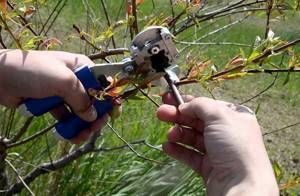
How to use the tool
Cutting and grafting work are carried out according to standard technology for grafting and budding of fruit and berry plantings. To keep the tool in working condition throughout the entire period of operation, it is imperative to provide the pruners with high-quality and timely, completely uncomplicated care:
- Garden tools must be kept dry and clean. Immediately after completing the entire scope of work, you need to wipe the blades and handles with a dry, clean rag, and then store them in a cover or special case;
- It is important to strictly follow the rules of winter preservation, which will prevent the formation of corrosive changes and a decrease in the sharpness of cutting surfaces. It is best to treat the blades and all moving parts with a special lubricant, then wrap the tool in a clean, soft, dry rag.
If, as a result of prolonged and direct contact of the cutting surfaces with water, rust appears on the blades, it is recommended to soak the tool in a container filled with gasoline or diesel fuel, then wipe, lubricate the pruning shears and put them away for winter storage.
It is very convenient and profitable to use professional and amateur equipment from well-established manufacturers. Unlike amateur models, professional knives are always hardened by cold forging. The resulting grafting is distinguished by a high level of survival, and caring for this type of garden equipment is not at all difficult, since even the procedure for replacing the knife is simplified as much as possible, and comes down to the need to unscrew a minimum number of fasteners.
Why are garden shears needed? Main purpose of the tool
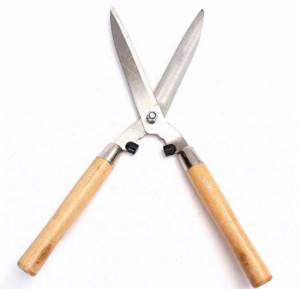
This tool should be classified as a hand tool. It is used to correct the length of shoots and thin branches. Used when caring for shrubs, grapes and tree crowns. Mostly necessary for landscaping the site and cutting off dried plant branches.
A standard pruner consists of the following elements:
- working blade;
- bolt;
- nuts;
- springs;
- support blade;
- buffers;
- castle;
- handles.
The success of a pruner is determined by the performance of the blade and its good cutting characteristics. The angles of the blade should be sharp to easily cut through plant stems, branches and other parts. Thanks to this, the process becomes correct, and the cut will ultimately be clean and smooth.
Important! The bolt must be tightened very tightly to ensure maximum operating torque.
After trimming, the spring facilitates the smooth return of the pruning shears to its place. Incorrect pressure can lead to breakage of the part, which will lead to malfunction of the tool as a whole. The support blade is slightly curved to reduce friction. There is a special dent on it through which juice flows.
But the lock helps to fix the pruning shears in their original position. This way you can avoid damage to the blade, as well as prevent the formation of any injuries.
